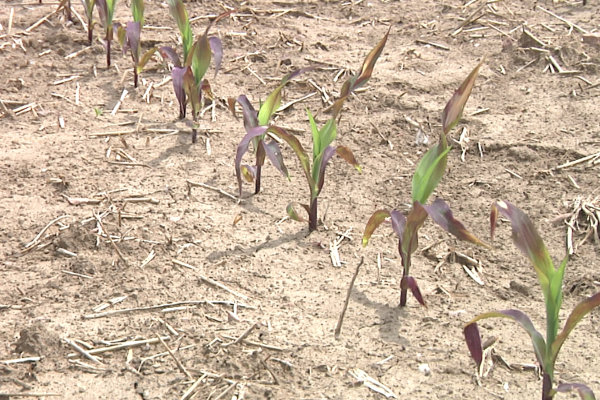WHAT’S THE BEST CROP TO PLANT
IN LAST YEAR’S PREVENT PLANT ACRES?
By Darren Hefty
THE CASE FOR CORN
If your prevent plant acres were a weedy mess or had a cover crop through much of the season, I’d argue that you should plant CORN in those fields this year. While some of the new herbicide tolerant soybean choices are pretty good for stopping weeds, corn is even better. You have a broad selection of herbicides you can use for broadleaves that you can’t use in any kind of soybeans on the market today such as Status and HPPD’s like Callisto, Laudis, Impact, and Armezon. Also, if you got a cover crop planted last year you’ve got a better chance to get into those fields earlier which fits with planting corn.
From a fertility availability standpoint, you very likely won’t have fallow syndrome in fields that had something growing in them last year due to good mycorrhizae bacteria and other beneficial micro survival.

Purpling in corn caused by phosphorus deficiency, a common symptom of fallow syndrome. Prevent plant acres without a cover crop are more prone to this due to a lack of living hosts for beneficial mycorrhizae fungi.
TIPS FOR PLANTING CORN ON
LAST YEAR’S PREVENT PLANT ACRES:
1. ADD BENEFICIAL MICROBES IN-FURROW AND/OR ON THE SEED.
Examples would be Hefty Complete Seed Treatment or applying Micro-Cycle in-furrow. Personally, I will do both on all my corn acres this year.
2. PLANTING TIME OR BANDED FERTILIZER WILL HELP MEET YOUR CORN’S EARLY NUTRIENT NEEDS.
We’ve seen this add more rows around on the ears and also lead to better early plant health. It often gets you to tassel quicker as well which leads to drier corn at harvest. I use Pro-Germinator along with Sure-K and Micro 1000. Rates vary depending on what else I’ve applied for fertilizer.
3. SEEDBED PREPARATION IS CRICICAL.

Do everything you can to make sure you have a nice seedbed to work with.
Creating a good seedbed will help your crop succeed. Tillage practices such as strip-tillage can help fluff up the seed zone prior to planting.
4. PICK A HYBRID WITH GREAT DEFENSIVE TRAITS.
Look for strong disease tolerance and pay specific attention to the seed treatment on the hybrids. I like ethaboxam fungicide and hybrid tolerance to anthracnose stalk rot for my farm.
TIPS FOR PLANTING SOYBEANS ON
LAST YEAR’S PREVENT PLANT ACRES:
1. USE THE BEST SEED TREATMENT YOU CAN FIND WITH MULTIPLE FUNGICIDE MODES OF ACTION.
DO NOT CUT THIS!
2. USE THE 3 PRE PROGRAM (THREE EFFECTIVE HERBICIDE MODES OF ACTION), PLUS PLANT XTEND OR ENLIST E3 SOYBEANS.
Who knows what weeds will come up – so be prepared.
3. USE BENEFICIAL MICROBIAL PRODUCTS THAT CONTAIN NUTRIENT SOLUBILIZERS.
Micro-Cycle is a great example.
4. SEEDBED PREPARATION IS IMPORTANT IN SOYBEANS, TOO.
5. PICK SOLID DEFENSIVE SOYBEAN VARIETIES THAT CAN HANDLE TOUGH GROUND.
Personally, I like soybeans with excellent standability in these types of situations to allow more air movement and potentially allow the ground to get back to its ideal misture concentration.
THE CASE FOR SOYBEANS
If your prevent plant acres were under water for an extended amount of time or if they were so wet that almost nothing grew in them . . . and I’ll add a third category, if you tilled the field multiple times so nothing was growing in the field, then I’d suggest soybeans as a better alternative than corn.
Here’s why:
